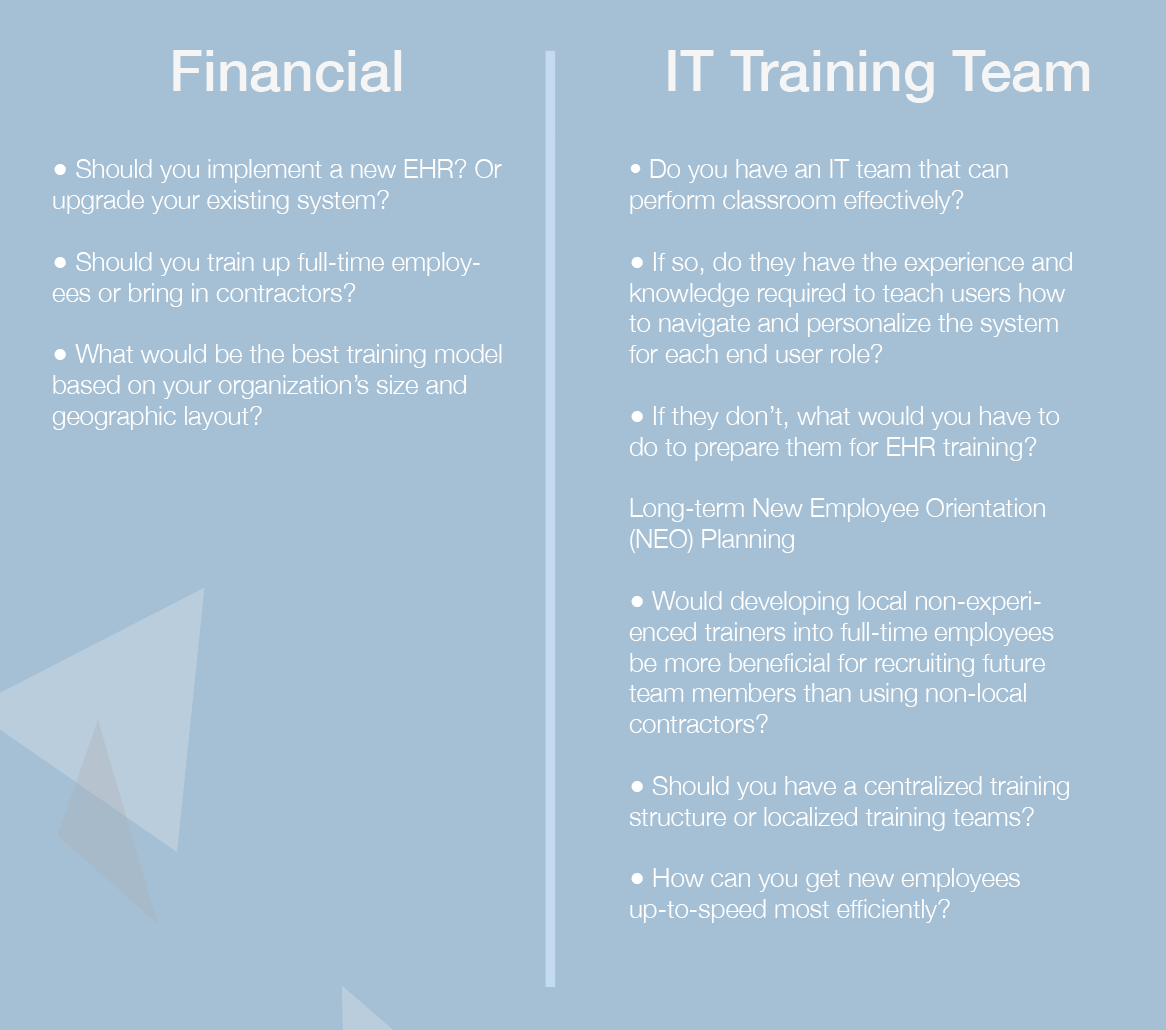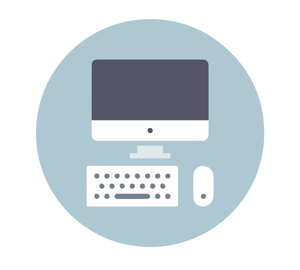Creative Solutions to EHR Training Challenges (Part One)


You might spend more on technology than training when implementing a new EHR or upgrading an existing system, but the effectiveness of your training may influence the return on your investment more than the capabilities of your technology. If your team doesn’t fully realize the benefits of the new technology, then you will not maximize your ROI. Creating an effective training program is key to increasing efficiency and productivity.
Your return on your investment in your EHR will only be as good as the benefits that you get from its usage. Whether you implement a new EHR or upgrade an existing one, the efficiencies you gain will depend on the proficiency of your users.
Effective EHR training is essential for maximizing productivity and ROI because users must know your system well to use it properly. But EHR training can be hard to do right and costly to do wrong. From budgeting for training, to hiring your trainers, to choosing the training methods you will use, every decision you make will influence the effectiveness of your training and the return on your investment.
Consider these common training challenges:
Financial
- Should you implement a new EHR? Or upgrade your existing system?
- Should you train up full-time employees or bring in contractors?
- What would be the best training model based on your organization’s size and geographic layout?
IT Training Team
- Do you have an IT team that can perform classroom effectively?
- If so, do they have the experience and knowledge required to teach users how to navigate and personalize the system for each end user role?
- If they don’t, what would you have to do to prepare them for EHR training?
- Long-term New Employee Orientation (NEO) Planning
- Would developing local non-experienced trainers into full-time employees be more beneficial for recruiting future team members than using non-local contractors?
- Should you have a centralized training structure or localized training teams?
- How can you get new employees up-to-speed most efficiently?
Each organization may answer these questions differently and approach training with various strategies. The following are examples of how some organizations have overcome common challenges that hospitals face when needing to train their staff.

1) Virtual EHR Training
Virtual training allows end users in multiple geographical locations to attend an interactive online classroom with their peers from all over the organization.
What are the benefits of virtual training?
- It is cost effective because you hire fewer trainers and pay less in travel costs for resources and end-users. End users from various locations can join “one virtual class.”
- Consistency is gained with how the system is utilized, such as through best practices and workflows, because a single trainer imparts the same lessons to users at all hospital locations.
- End users feel more confident they can ask questions anonymously through an instant messaging system or virtual platform. This improves participants’ retention of the training curriculum.
- Less training space is reserved as multiple applications can be trained in the same room.
- Small groups can be educated efficiently by having many programs with fewer attendees transformed into self-lead classes, like for pharmacists and dietitians.
How do you implement virtual EHR training?
Virtual training may be cost-efficient, however the efficiency you derive from it will depend on how strategically you implement it in your organization. Ask questions such as the following:
- How many classes per month would be optimal?

- How many full-time trainers would you need? And how about part-time trainers?
- How would you use coaches?
- Would you still do assessments?
- Would you use centralized training centers or localized classrooms?
What types of situations are ideal for virtual training?
Virtual EHR training is well suited for large groups dispersed widely geographically and for purposes in which message consistency is vital. For example, it would be a good fit for:
- New-employee orientation
- EHR upgrades
- Organizations with expansive geographic coverage, remote locations
- Need for consistent curriculum across the organization
- Full or part-time training resources
What should you look for in a software platform?
Your “classrooms” may be virtual but should still be comfortable, practical and conducive to learning. Incorporate these features:
- Instant messaging
- Capacity for a large number of attendees
- Ability to share instructor screen
- Ability to take attendance
- Dependable audio, especially if used from an outside vendor. Use a third-party audio vendor if you expect a high volume of attendees per class.
What are the challenges in using virtual training?
Expect to prepare for at least six months to implement a virtual training program. Collaboration must occur before you begin a transformation. For example, NEO schedules must be matched and classrooms set up.
Here are just a few factors to consider:
- Registration with your current learning management system (LMS) and registration workflow
- Course curriculum adjustments for your long-term needs to be determined. Combining VT, e-learning, partial VT and hands-on practice within units
- Workflow for updating materials
2) Hiring Non-Experienced Local EHR Trainers
In some ways, knowing an organization and the communities it serves can be as valuable as knowing the EHR system you will be training your team to use. Using non-experienced local trainers provides a community focus and lets you concentrate on patient care while you recruit members of the community to join your credentialed training team.
You also can save money by hiring locally. One organization saved $49/hour per trainer by hiring 48 local trainers at an average of $65/hour compared to the 72 non-locals they contracted at $114/hour.
Why is it cheaper than hiring experienced non-locals?
Hospitals don’t have to pay expenses of $1,000 to $2,000 a week per trainer.
What should you look for when hiring non-experienced EHR trainers locally?
Hire multiple resources at a time through a “temp-to-perm” model that lets you work with them before hiring as full-time employees. This helps ensure the quality and qualifications of future employees.
When screening candidates, look for connections to the community and the organization that may indicate a commitment to learning and helping. Non-experienced local resources often are driven to succeed because they see your project as an opportunity to get hired on by the local health system. Ask candidates for examples of how they have learned and taught in the past to get a sense of their abilities to assimilate and communicate the training curriculum.

How can you bring new trainers up to speed?
Partnering a local non-experienced resource with an experienced trainer can speed the learning process for the former while sharpening the teaching skills of the latter.
You should also vary the types of learning opportunities. The organization that hired 48 local non-experienced EHR trainers put all of them through a six-week credentialing program where they learned not only the content, but the clinical workflows and policies, and were then required to teach-back the content. The trainers also performed sample lessons in front of panels and were required to pass an assessment.
Other than cost savings, what are other benefits to hiring locals?
- Trainers who are familiar with the area know how to use local transportation efficiently.
- Local resources also have personal experience with the hospital so there is an accompanying sense of ownership or pride that comes with their job.
- Non-experienced local CTs often want to stay on after their contract and can be outstanding hires.
What are some challenges with this model?
Some non-experienced resources struggle to develop the depth of knowledge necessary or the skill set required to conduct proper training. If they are credentialed, they may not be viewed as helpful as expected to end users during go-live because they are learning your industry.
Even if they become excellent teachers, your inexperienced resources who have only seen a limited aspect of EMRs could experience difficulty working with end users who are accustomed to how certain aspects or modules operate in their legacy EMR. Clinicians could treat such resources harshly out of a lack of respect, thus undermining their effectiveness as EHR trainers.
Stay tuned for Part Two of this blog post that will explore hiring local in larger metro areas, e-learning, and feature EHR training and adoption tips.
